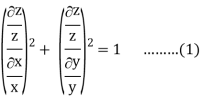Unit – 2
First order partial differential equations
Q1) What are partial differential equations?
A1)
A partial differential equation (PDE)is an equation involving one or more partial derivatives of an (unknown) function, call it u, that depends on two or more variables, often time t and one or several variables in space. The order of the highest derivative is called the order of the PDE. Just as was the case for ODEs, second-order PDEs will be the most important ones in applications.
Just as for ordinary differential equations (ODEs) we say that a PDE is linear if it is of the first degree in the unknown function u and its partial derivatives. Otherwise we call it nonlinear.
Q2) Solve 
A2)
We have, 
Separating the variables we get
(sin y + y cos y )dy ={ x (2 log x +1} dx
Integrating both the sides we get 





Q3) Solve 
A3)
We have

Let z = ax + by + c ... (2)

On substituting the values of p and q in (1), we have

Putting the value of b in (2), we get

Q4) Solve 
A4)
Let u = x + by
So that

Substituting these values of p and q in the given equation, we have








Q5) Solve- x2p2 + y2q2 = z2
A5)
This equation can be transformed as-
x2/z2 p2 + y2/z2 q2 = 1
(x/z . z/x)2 + (y/Z . z/y)2 = 1

Let
z/z = Z, x/x = X, y/y = Y
Log z = Z, log x = X, log y = Y
Equation (1) can be written as-

P2 + Q2 = 1 ……….(2)
Let the required solution be-
Z = aX + bY + c
P = Z/X = a, Q = Z/Y = b
From (2) we have-
a2 + b2 = 1 or b = 
Z = aX +  Y + c
Y + c
Log z = a log x +  log y + c
log y + c
Q6) Solve-

A6)
Let-

That means-
p = x2 +c and q = c – y2
Put these values of p and q in
Dz = pdx + qdy = (x2 + c) dx + (c – y2) dy
z = (x3/x + cx) + (cy – y3/3) + c1
Q7) Solve 
A7)
Rewriting the given equation as

The subsidiary equations are 
The first two fractions give 
Integrating we get  n (i)
n (i)
Again the first and third fraction give xdx = zdz
Integrating, we get 
Hence from (i) and (ii), the complete solution is

Q8) Solve 
A8)
Here the subsidiary equations are 
Using multipliers x,y, and z we get each fraction = 
 which on integration gives
which on integration gives 
Again using multipliers l, m and n we get each fraction 
 which on integration gives lx +my +nz = b (ii)
which on integration gives lx +my +nz = b (ii)
Hence from (i) and (ii) the required solution is 
Q9) Solve 
A9)
Here the subsidiary equations are 
From the last two fractions, we have 
Which on integration gives log y = log z + log a or y/z=a (i)
Using multipliers x, y and z we have
Each fraction 
Which on integration gives 
Hence from (i) and (ii) the required solution is 
Q10) Solve (
A10)
Here we have
(
The auxiliary equations are

Or



Integrating first members of (2), we have
Log (x – y) = log (y –z) + log c1

Similarly from last two members of (2), we have

The required solution is

Q11) Solve-

A11)
We have-

Then the auxiliary equations are-

Consider first two equations only-


On integrating
x2/2 = - y2/2 + C1/2 x2 + y2 = C1
…….. (2)
Now consider last two equations-


On integrating we get-
y2 = yz + C2
y2 – yz = C2
…………… (3)
From equation (2) and (3)-
x2 + y2 = f(y2 – yz)
Q12) Using the method of separation of variables, solve


A12)

Let, u = X(x). T (t). (2)
Where X is a function of x only and T is a function of t only.
Putting the value of u in (1), we get


(a) 
On integration log X = cx + log a = log 


(b)
On integration 



Putting the value of X and T in (2) we have



But, 
i.e. 

Putting the value of a b and c in (3) we have


Which is the required solution.
Q13) Using the method of separation of variables, solve  Where
Where 
A13)
Assume the given solution 
Substituting in the given equation, we have




Solving (i) 
From (ii) 
Thus 
Now, 

Substituting these values in (iii) we get

Which is the required solution